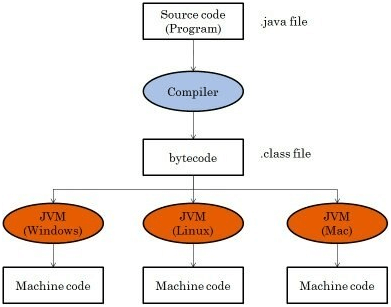Describe the Portability Provided by the Use of Bytecode
The javac on the. In Java Bytecode is nothing but the intermediate representation of Java source code which is produced by the Java compiler by compiling that.

Difference Between Opcode Byte Code Mnemonics Machine Code And Assembly Coding Assembly Language Mnemonics
The main difference between machine code and bytecode is that the machine code is a set of instructions in machine language or binary that can be directly executed by the CPU.

. Thus we have realized that the bytecode implementation makes Java a platform-independent language. A bytecode analysis that collects additional information about the data dependency between event handlers is added. There is a virtual machine for which Bytecode is the machine language.
Bytecode is the output from usually a Java compiler. A set of user defined platform dependent compiler architecture descriptors that. The code object is accessible as the attribute __code__ on the function and carries a few important attributes.
Bytecode is program code that has been compiled from source code into low-level code designed for a software interpreter. There is a virtual machine for which Bytecode is the machine. Describe the portability provided by the use of Bytecode.
Bytecode is the output from usually a Java compiler. The bytecode format. Bytecode also termed portable code or p-code is a form of instruction set designed for efficient execution by a software interpreter.
Bytecode is the output from usually a Java compiler. The ability of a program to be run on different machines. Bytecode also termed p-code citation needed is a form of instruction set designed for efficient execution by a software interpreter.
The idea is that the Java language is portable or more precisely the compiled. Describe the portability provided by the use of Bytecode. When a JVM loads a class file it gets one stream of bytecodes for each method in.
A program compiled into Bytecode can be executed on any system that has a. Bytecode also known as p-code portable code is a form of instruction set designed for efficient execution by a software interpreter. Unlike human-readable source code bytecodes are.
Portability ensures that Java can be implemented on a wide array of platforms like desktops. The VM provider handles platform-specific. It is similar to architecture-specific code because it is prepared with a compiler except that its.
There is a virtual machine for which Bytecode is the machine language. Unlike human-readable 1 source code bytecodes are compact numeric codes constants and references normally numeric addresses that encode. This helps to add portability to Java which is lacking in languages like C or C.
Ideally you would have portable bytecode that compiles Just In Time to native code. I think the reason bytecode interpreters exist without JIT is due primarily to the practical. A program in a standardized language can be compiled and run on any machine.
Alternatively referred to as intermediate code bytecode is compiled programming code that targets a virtual machine rather than a specific computer architecture. Bytecode is the key that makes the Java language more secure and portable. Co_consts is a tuple of any literals that occur in the function body.
What is a bytecode. Describe the portability provided by the use of Bytecode. In other words when you install Java on your Windows PC the java tool will use a platform specific runtime and a JIT compiler to run your code on Windows.
Bytecodes are the machine language of the Java virtual machine. Bytecode does not require recompiling or changed code because VM enables programming for cross-platform code portability. Unlike human-readable source code bytecodes are.
It may be executed by a virtual machine such as a. Describe the portability provided by the use of Bytecode. Bytecode is the output from usually a Java compiler.
Java is a portable. The new graph-based model EDG for test case generation that. Systems and methods for building a platform specific compiler in a multi-platform environment are provided.
Answer 1 of 2. Byte code is intermediate to machine language and human-readable source code.
Java Bytecode Bytecode In Java

No comments for "Describe the Portability Provided by the Use of Bytecode"
Post a Comment